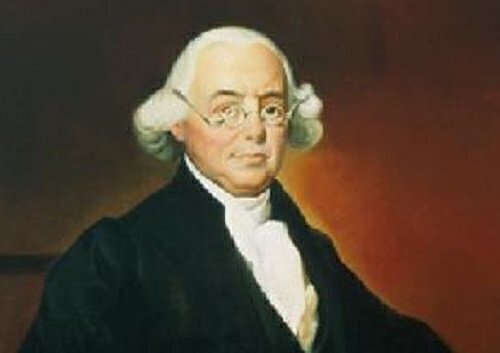
These days, many Americans have heard the term “Electoral College” thrown around in conversation. Like the groundhog every February, the Electoral College sticks its metaphorical head out every four years. For some, the term evokes warmth; for others, contempt. But what exactly is it and why does it play a significant role in the American political system?
The Electoral College is the mode by which the country officially elects the President of the United States. It is a system that was designed in the Constitutional Convention in Philadelphia during the summer of 1787, and one of its chief architects is a man known to few Americans.
James Wilson was born in Scotland in 1742 and arrived in Pennsylvania in his early twenties; he later became eventually a delegate to the Second Continental Congress and signer of the Declaration of Independence in 1776. Eleven years later, he returned to the same room where he signed the Declaration in order to participate in the Constitutional Convention, once again representing Pennsylvania. The summer of 1787 would be the pinnacle of his professional career.
A supporter of a strong, centralized government, Wilson joined the likes of James Madison and another Pennsylvania delegate, Gouverneur Morris, as the leading advocates for revamping the system of government in the United States. They were also the major speakers in the early part of the Constitutional Convention, dominating the opening weeks of the proceedings with calculated and strong arguments.
Undoubtedly, Madison was the faction leader; prior to the Convention, he wrote out the various problems of the Articles of Confederation in “Vices of a Political System,” and arrived early to Philadelphia with a plan of government already sketched out – the Virginia Plan. The part of the plan pertaining to the executive branch caused much discussion, but was not detailed or specific about how large or what powers the branch would have. Madison himself was uncertain about the executive’s scope and structure.
James Wilson was not.
Wilson, in early June, called for the executive branch to be filled by a “single magistrate” who would fill the position with “vigor, dispatch, and responsibility.” For Wilson, the doctrine of separation of powers was entirely essential if the new framework of government was to succeed. Each of the branches of government needed independence from one another, not simply in their functions and interactions with one another, but also in their selection. It is here where Madison and Wilson differed: the Virginia Plan’s Seventh Resolution stated that “a National Executive be instituted; to be chosen by the National Legislature for the terms of years.” In Wilson’s mind, this was a clear violation of the separation of powers. Having a branch of government actively participate in the election of another branch would ensure that the executive would be chained to the interests of the national legislature. Instead, Wilson recommended that the executive be elected by the people, a proposal that other delegates saw as unrealistic and not worthy of consideration.
The backdrop of the Constitutional Convention, it’s important to note, was the issue of representation. How were the people and the states going to be represented in this new framework? It was an issue that Wilson was passionate about, as he believed that the power of the new government should reside in the people – not in the states, which held power under the discredited Articles of Confederation.
The issue of representation eventually leaked into the discussions on how the executive branch was to be elected. The primary conflict, however, did not include the people as a whole, who were mainly an afterthought. Instead, it was a titanic struggle between delegates who wanted the power of electing the executive placed in the national legislature, and delegates who wanted the state legislatures involved. Wilson’s suggestion that the people elect the executive branch brought the afterthought to the fore. In fact, at the time, Madison noted that there was a considerable pause in the room after Wilson’s recommendation, and even Wilson himself believed that the plan was not likely to succeed. But it did plant a seed for later.
It was not until September 6 that the Electoral College was largely built and agreed upon. The Committee of Eleven handled the unsettled business from the rough draft of the Constitution. Between September 6 and 7, the delegates agreed upon a four-year term for the President, who had to be a natural-born citizen. The President could also be reelected without term limits. The next day, the delegates agreed upon the power of treaty-making for the President, and agreed that the President could be impeached for “high crimes and misdemeanors.”
In the end, the Electoral College was just one in a series of compromises that the Framers of the Constitution made to ensure its completion. Much like the other compromises, the Electoral College was a mixture of population-based and state-based principles, which ensured the inclusion of the people, albeit indirectly, in the mode of electing the President. The true intention of the Electoral College was shattered almost immediately with the unforeseen rise of political parties.
While many Americans today may feel ambivalent about the Electoral College, it was never considered to be a perfect feature of the Constitution. But despite its imperfections, it was the best the Framers could create and support. It’s also a reminder of Benjamin Franklin’s last speech at the Convention – read by Wilson due to Franklin’s poor health – in which the great philosopher declared his consent “to this Constitution because I expect no better, and because I am not sure, that is not the best.” Franklin agreed to “this Constitution with all its faults” because he thought “a general Government necessary for us, and there is no form of Government but may be a blessing to the people” so as long as it was well administered. It was a reminder that the Constitution starts with “We, the People.”
Matt Riffe is a museum programs demonstrator at the National Constitution Center.






